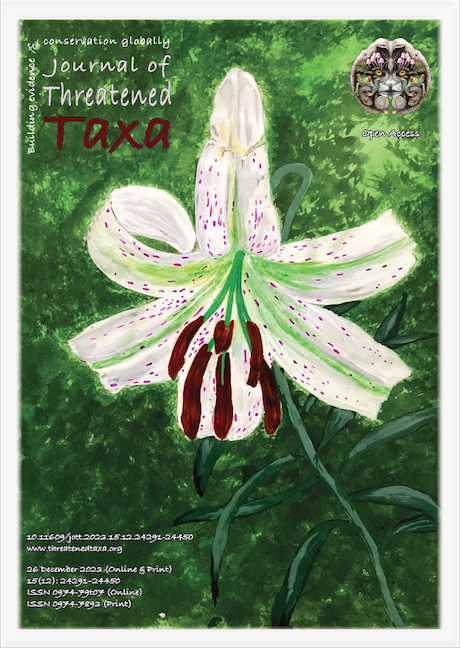Notes on Discospermum sphaerocarpum Dalzell ex Hook.f., a rare species of Rubiaceae (Ixoroideae: Coffeeae) from southern India
DOI:
https://doi.org/10.11609/jott.8698.15.12.24420-24426Keywords:
Conservation, endemism, laterite ecosystems, Madayippara, sacred grovesAbstract
Discospermum sphaerocarpum is a rare species in the tribe Coffeeae of the family Rubiaceae and its occurrence on the Madayippara lateritic plateau of the Kannur district of Kerala, southern India is discussed. This plant is endemic to southern India and Sri Lanka. In Kerala, this species was previously recorded from the low-altitude evergreen forests of Thiruvananthapuram district. The present study gives a detailed description, distribution and figures & images illustrating the diagnostic characters of D. sphaerocarpum for easy identification and conservation.
References
Ali, S.J. & E. Robbrecht (1991). Remarks on the tropical Asian and Australian taxa included in Diplospora or Tricalysia (Rubiaceae—Ixoroideae—Gardenieae). Blumea 35(2): 279–305.
Andreasen, K. & B. Bremer (2000). Combined phylogenetic analysis in the Rubiaceae-Ixoroideae: morphology, nuclear and chloroplast DNA data. American Journal of Botany 87(11): 1731–1748. https://doi.org/10.2307/2656750
Arriola, A.H., A.P. Davis, N.M. Davies, U. Meve, S. Liede-Schumann & G.J.D. Alejandro (2018). Using multiple plastid DNA regions to construct the first phylogenetic tree for Asian genera of Coffeeae (Ixoroideae, Rubiaceae). Botanical Journal of the Linnean Society 188(2): 132–143. https://doi.org/10.1093/botlinnean/boy059
Biag, R.D. & G.J.D. Alejandro (2021). Rubiaceae flora of northern Sierra Madre Natural Park, Isabela, Luzon, Philippines: Species richness, distribution, and conservation status. Philippine Journal of Science 150(3): 907–921.
Dalzell, N.A. (1850). Discospermum genus novum. Hook. Journ. Bot. Kew Gard. Misc. 2: 257- 258.
Dassanayake, M.D. (1998). A Revised Handbook to the Flora of Ceylon. Oxford & IBH Publishing Co. Pvt. Ltd., New Delhi.
Davis, A.P., M. Chester, O. Maurin & M.F. Fay (2007). Searching for the relatives of Coffea (Rubiaceae, Ixoroideae): the circumscription and phylogeny of Coffeeae based on plastid sequence data and morphology. American Journal of Botany 94(3): 313–329. https://doi.org/10.3732/ajb.94.3.313
Fosberg, F.R. & M.H. Sachet (1965). Manual of Tropical Herbaria (Regnum Vegetabile 39). International Bureau for Plant Taxonomy and Nomenclature, Utrecht, Netherlands, 132 pp.
Gamble, J.S. & C.E.C. Fischer (1921). The Flora of the Presidency of Madras, Volume 2. Adlard & Son Ltd., London.
Hooker, J.D. (1880). Rubiaceae. Flora of British India 3: 17–210.
Nadkarni, K.M. (1976). Indian Materia Medica. Popular Prakashan Private ltd., Bombay, 454 pp.
Narayanasami, D. & B. Natesan (2020). Endemic vascular plants from the Coromandel Coast of Tamil Nadu, southern India, pp. 89–107 In: Kumar, S. (Ed.). Endangered Plants. IntechOpen, 180 pp. https://doi.org/10.5772/intechopen.94333
POWO (2023). Plants of the World Online. Facilitated by the Royal Botanical Gardens, Kew. Discospermum Dalzell. https://powo.science.kew.org/results?q=discospermum. Accessed on 30 June 2023.
Pramod, C. & A.K. Pradeep (2020). A Hillock of Biodiversity - Ecology and Flora of Madayippara, A South Indian lateritic Plateau. Indian Association for Angiosperm Taxonomy, Calicut.
Pramod, C. & A.K. Pradeep (2021). Observations on the flowering plant diversity of Madayippara, a southern Indian lateritic plateau from Kerala, India. Journal of Threatened Taxa 13(2): 17780–17806. https://doi.org/10.11609/jott.3883.13.2.17780-17806
QGIS (Quantum GIS Development Team) (2022). Quantum GIS geographic information system. Version 3.28.2. Downloaded on 4 January 2023.
Robbrecht, E. & C. Puff (1986). A survey of the Gardenieae and related tribes (Rubiaceae). Botanische Jahrbucher fur Systematik, Pflanzengeschichte und Pflanzengeographie 108: 63–137.
Sasidharan, N. (2004). Biodiversity documentation for Kerala. Part 6. Flowering Plants. Kerala Forest Research Institute, Peechi, Thrissur, 237 pp.
Singh, P., K. Karthigeyan, P. Lakshminarasimhan & S.S. Dash (2015). Endemic vascular plants of India. Botanical Survey of India, Kolkata, 239 pp.
Tosh, J., A.P. Davis, S. Dessein, P. De Block, S. Huysmans, M.F. Fay, E. Smets & E. Robbrecht (2009). Phylogeny of Tricalysia (Rubiaceae) and its relationships with allied genera based on plastid DNA data: Resurrection of the genus Empogona. Annals of the Missouri Botanical Garden 96(1): 194–213. https://doi.org/10.3417/2006202
Uddin, M.S., A. Mazumder & S.B. Uddin (2023). Addition of one hundred and forty-seven new vascular taxa to the flora of Bangladesh. Species 24: 1–8. https://doi.org/10.54905/disssi/v24i73/e13s1013
Published
Issue
Section
License
Copyright (c) 2023 C. Pramod, V.V. Drisya, A.K. Pradeep, K.T. Chandramohanan

This work is licensed under a Creative Commons Attribution 4.0 International License.
Authors own the copyright to the articles published in JoTT. This is indicated explicitly in each publication. The authors grant permission to the publisher Wildlife Information Liaison Development (WILD) Society to publish the article in the Journal of Threatened Taxa. The authors recognize WILD as the original publisher, and to sell hard copies of the Journal and article to any buyer. JoTT is registered under the Creative Commons Attribution 4.0 International License (CC BY), which allows authors to retain copyright ownership. Under this license the authors allow anyone to download, cite, use the data, modify, reprint, copy and distribute provided the authors and source of publication are credited through appropriate citations (e.g., Son et al. (2016). Bats (Mammalia: Chiroptera) of the southeastern Truong Son Mountains, Quang Ngai Province, Vietnam. Journal of Threatened Taxa 8(7): 8953–8969. https://doi.org/10.11609/jott.2785.8.7.8953-8969). Users of the data do not require specific permission from the authors or the publisher.





